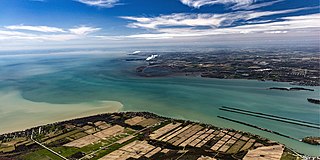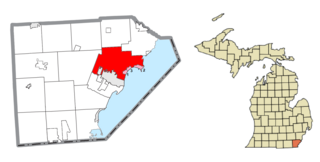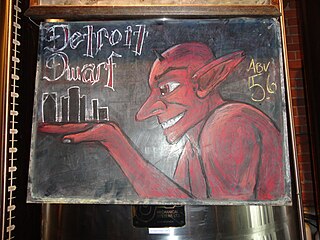Related Research Articles

The Detroit River flows west and south for 24 nautical miles from Lake St. Clair to Lake Erie as a strait in the Great Lakes system. The river divides the metropolitan areas of Detroit, Michigan, and Windsor, Ontario—an area collectively referred to as Detroit–Windsor—and forms part of the border between Canada and the United States. The Ambassador Bridge, the Detroit–Windsor Tunnel, and the Michigan Central Railway Tunnel connect the cities.

Monroe County is a county in the U.S. state of Michigan. As of the 2020 Census, the population was 154,809. The largest city and county seat is Monroe. The county was established as the second county in the Michigan Territory in 1817 and was named for then-President James Monroe.

Frenchtown Charter Township is a charter township within Monroe County in the U.S. state of Michigan. The population was 20,428 at the 2010 census.

Monroe is the largest city and county seat of Monroe County, Michigan, United States. The population was 20,462 as of the 2020 census. The city is bordered on the south by Monroe Charter Township, but the two are administered autonomously. Monroe is the core city in the Monroe metropolitan area, which is coterminous with Monroe County and had a population of 154,809 in 2020. Located on the western shores of Lake Erie approximately 14 miles (23 km) north of Toledo, Ohio and 25 miles (40 km) south of Detroit, the city is part of the Detroit–Ann Arbor–Flint combined statistical area.

The Nain Rouge also called "Demon of the Strait", is a legendary creature of the Detroit, Michigan area whose appearance is said to presage misfortune. Its origins in the early French settlement of Detroit are proposed as deriving from Norman French tales of the lutin, a type of hobgoblin, along with Native American legends of an "impish offspring of the Stone God".

The Great Lakes region of North America is a binational Canadian–American region centered around the Great Lakes that includes eight U.S. states and the Canadian province of Ontario. Canada´s Quebec province is at times included as part of the region because the St. Lawrence River watershed is part of the continuous hydrologic system. The region forms a distinctive historical, economic, and cultural identity. A portion of the region also encompasses the Great Lakes megalopolis.

The Odawa, believed to derive from an Anishinaabe word meaning "traders", are an Indigenous American ethnic group who primarily inhabit land in the Eastern Woodlands region, commonly known as the northeastern United States and southeastern Canada. They have long had territory that crosses the current border between the two countries, and they are federally recognized as Native American tribes in the United States and have numerous recognized First Nations bands in Canada. They are one of the Anishinaabeg, related to but distinct from the Ojibwe and Potawatomi peoples.

The River Raisin is a river in southeastern Michigan, United States, that flows through glacial sediments into Lake Erie. The area today is an agricultural and industrial center of Michigan. The river flows for almost 139 miles (224 km), draining an area of 1,072 square miles (2,780 km2) in the Michigan counties of Lenawee, Washtenaw, Jackson, Hillsdale, and Monroe County, where its mouth at Lake Erie is located. French settlers named it as La Rivière aux Raisins because of the wild grapes growing along its banks, the French word for grape being raisin. The French term for "raisin" is raisin sec.

The Métis are an Indigenous people whose historical homelands includes Canada's three Prairie Provinces, as well as parts of British Columbia, the Northwest Territories, Northwest Ontario and the Northern United States. They have a shared history and culture, deriving from specific mixed European and Indigenous ancestry, which became distinct through ethnogenesis by the mid-18th century, during the early years of the North American fur trade.

The Battles of Frenchtown, also known as the Battle of the River Raisin and the River Raisin Massacre, were a series of conflicts in Michigan Territory that took place from January 18–23, 1813, during the War of 1812. It was fought between the United States of America and a joint force of British and Native American near the River Raisin in Frenchtown.

Sandy Creek is an 18.5-mile-long (29.8 km) creek located entirely within Monroe County in the U.S. state of Michigan. The creek rises in London Township in the north-central portion of the county and flows southeast into Lake Erie in Frenchtown Charter Township at Sterling State Park.

Fort Pontchartrain du Détroit or Fort Detroit (1701–1796) was a fort established on the north bank of the Detroit River by the French officer Antoine de la Mothe Cadillac and the Italian Alphonse de Tonty in 1701. In the 18th century, French colonial settlements developed on both sides of the river, based on the fur trade, missions, and farms.
USS Somers was a schooner, formerly Catherine, purchased by the United States Navy in 1812. She was purchased for $5,500 from Jacob Townsend, a pioneer and one of the first settlers of Lewiston, New York and purveyor of goods on the Great Lakes. She fought in the War of 1812 under the command of Commodore Oliver Hazard Perry on Lake Erie and Lake Huron, and took part in the capture of the British Squadron on 10 September 1813. She was captured by the British in 1814, and taken into service as HMS Huron.

The history of human activity in Michigan, a U.S. state in the Great Lakes, began with settlement of the western Great Lakes region by Paleo-Indians perhaps as early as 11,000 B.C.E. One early technology they developed was the use of native copper, which they would fashion into tools and other implements with "hammer stones". The first Europeans to arrive in Michigan were the French. Explorer Étienne Brûlé traveled through Michigan in 1618 searching for a route to China. Soon the French laid claim to the land and began to trade with the local natives for furs. Men called "voyageurs" would travel the rivers by canoe trading various goods for furs that would bring a high price back in Europe.

William C. Sterling State Park is a public recreation area located in Frenchtown Charter Township with a small portion lying within the city limits of Monroe, Michigan. It is the only Michigan state park located on Lake Erie. The park encompasses 1,300 acres (530 ha) of mostly man-made lagoons and beachfront near the mouth of Sandy Creek. The main attractions at the park include a 256-site campground, beach area, boat launch, and shore fishing lagoons. There are over seven miles (11 km) of biking and hiking trails within the park.
Joseph Bailly was a fur trader and a member of an important French Canadian family that included his uncle, Charles-François Bailly de Messein.

The following outline provides an overview of and topical guide to the U.S. state of Michigan:

The River Raisin National Battlefield Park preserves the site of the Battle of Frenchtown as the only national battlefield marking a site of the War of 1812. It was established as the 393rd unit of the United States National Park Service under Title VII of the Omnibus Public Land Management Act, which was signed into law on March 30, 2009. The park is located in the city of Monroe in Monroe County, Michigan. It was designated as a Michigan Historic Site on February 18, 1956 and was added to the National Register of Historic Places on December 10, 1982. The house at 1403 East Elm Avenue was added to the National Register listing in 2019. It officially began operation as a national park unit on October 22, 2010.

The Campau family of Detroit, Michigan, was established when brothers Michel and Jacques Campau settled in Detroit, Michigan in 1707 and 1708, respectively. Jacques, Joseph Campau, and Barnabé Campau are among the Barons of Detroit, according to Richard R. Elliott, because they had "ancestral virtues most worthily perpetuated."
References
- ↑ Au, Dennis. "The Mushrat French: The Survival of French Canadian Folklife on the American Side of le Détroit" (PDF). Retrieved 30 July 2021.
- 1 2 3 Naveaux, Ralph J. (2007). "Remnants of "Mushrat French" Cuisine in Monroe, Michigan" (PDF). Repast . Culinary Historians of Ann Arbor. 23 (2): 3–6. Retrieved 30 July 2021.
- 1 2 LaForest, James (Fall 2014). ""Muskrat French": Origins of a Culture, a Language, and a People". Michigan Historical Review. 40 (2): 98–99. doi:10.5342/michhistrevi.40.2.0087. JSTOR 10.5342/michhistrevi.40.2.0087.
- ↑ Hubbard, Bela (1877). "The Early Colonization of Detroit". Michigan Pioneer Historical Collections. I: 352.
- ↑ "Marche du Nain Rouge" . Retrieved 4 September 2015.
- ↑ "Major Muskrat Youth Programs". River Raisin National Battlefield Park Foundation. River Raisin National Battlefield Park Foundation. Retrieved 4 September 2015.
- ↑ Sleeper-Smith, Susan (2001). Indian Women and French Men. Amherst: University of Massachusetts Press. pp. 3–5. ISBN 978-1-55849-310-0.
- ↑ "Senate Resolution 0182 (2014)". Michigan Legislature. State of Michigan. Retrieved 4 September 2015.
- ↑ "House Resolution 0173 (2013)". Michigan Legislature. State of Michigan. Retrieved 4 September 2015.
- ↑ Beneteau, Marcel (2008). Mots Choisis. Ottawa, Ontario: University of Ottawa Press. ISBN 978-2760330368.
- ↑ Beneteau, Marcel. "Detroit River: A Special Place in French North American History". Encyclopedia of French Cultural Heritage in North America. Encyclopedia of French Cultural Heritage in North America. Retrieved 8 September 2015.